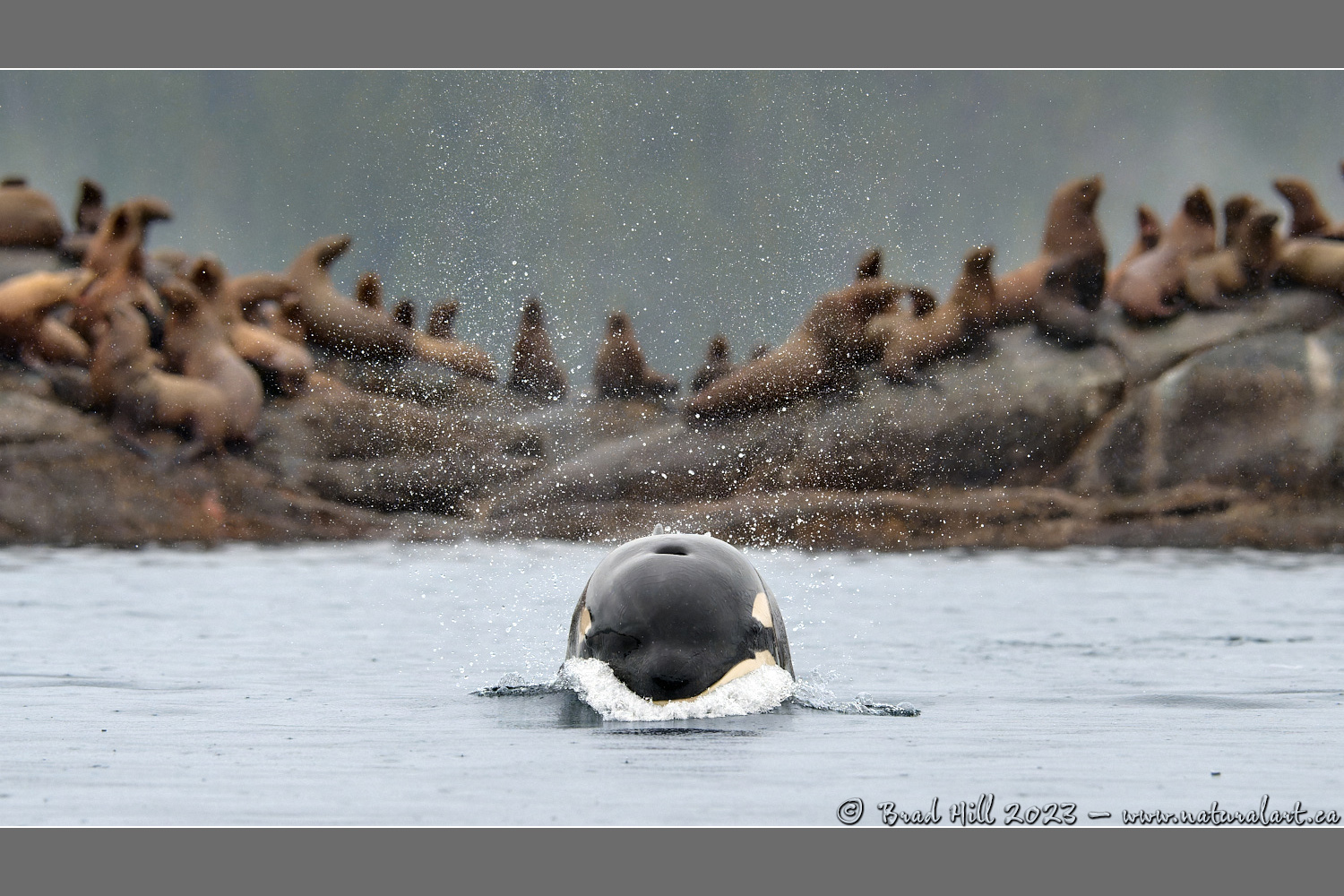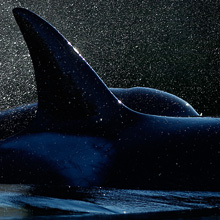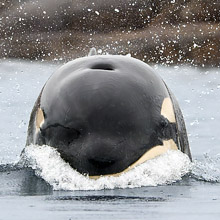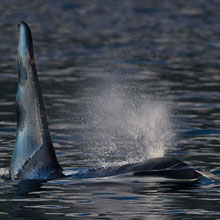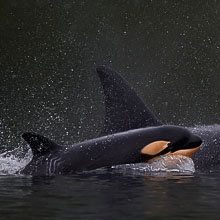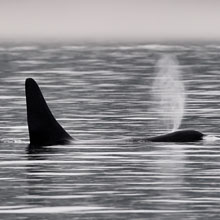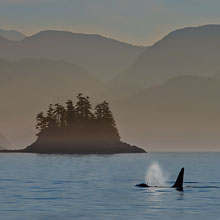Availability: Limited Edition Print
In the Field
A Sea Lion's Worst Nightmare. Great Bear Rainforest, British Columbia, Canada. September 23, 2023.
Orcas (AKA Killer Whales) can be found throughout virtually all the channels and inlets in the Great Bear Rainforest. We see and photograph them quite frequently during all my various photo tours in the Great Bear Rainforest (though we don't commonly see them in the Khutzeymateen Inlet). Within the waters of the Great Bear Killer Whales come in two "flavours" - Resident Killer Whales which consume fish and Transient Killer Whales (AKA Bigg's Killer Whales) which consume marine mammals. This image is of one member of a small pod of transients that decided Steller Sea Lions were on the day's menu!
This Killer Whale encounter was one of the highlights of my 2023 photo tour season. At the time we were photographing a large group of Steller Sea Lions on a haulout rock. We had been careful not to spook the sea lions and the bulk of them were quietly (for a sea lion!) sleeping. Suddenly a large wave hit the opposite side of the rocks and the lions started kicking up a huge and very loud ruckus. And then we saw the Killer Whales...and it was dramatic! The vast majority of the sea lions stayed on the rocks, but some - that were apparently lacking experience and/or intelligence - took to the water. And...one got picked off by the big bull of the Killer Whale pod. While most of the action took place under water and out of view, the bull did surface several times with a large hunk of "meat" in its mouth. I was trying to capture a shot of the Killer Whales that reflected the energy and excitement of the encounter when one of the Killers surfaced (and blew) while swimming directly at us...and with the sea lions in the background. That's when I nabbed this shot.
This image was captured with my "last and only" F-mount lens I still regularly use for wildlife photography - my 120-300mm f2.8E lens. While this lens is massive and really heavy, I just love its optics and its AF speed is amazing. I was really glad I had it with me and mounted on one of my Z 9's during this encounter.
Nikon's Z-mount wildlife lens collection is now very well filled out and has enough different options to make almost any wildlife photographer happy. But, at the time of this writing (8 January 2024) there is no Z-mount version of the 120-300mm f2.8. I have no idea where this lens sits in Nikon's priority list of new Z lenses to churn out. The lens isn't really that popular among wildlife shooters, but a decent number of pro sports shooters are quite partial to it. Given I use this lens only in very specific situations (that aren't that common) I'm personally a bit on the fence about whether I should just keep and use my F-mount version or jump on the Z-mount version when it becomes available. My thinking on the matter is being dominated by two things...
First, if Nikon chooses to add a built-in 1.4x to the Z-mount version of the 120-300mm f2.8 (and I wouldn't be surprised if it ends up being a 100-300mm f2.8) I would very likely go for it. The existing F-mount version of the 120-300mm works very well with the TC-14EIII, making it a top notch "up to 420mm" f4 lens as well. The added convenience of having the TC built-in would increase the value of the lens to me significantly.
Second, while I have never noticed any negative impact of using a FTZ adapter on the AF speed, VR performance, or the optics of a lens, there is ONE rarely noticed (by most photographers) problem with using an FTZ with any Z-mount lens. That problem? Poor moisture sealing at the lens-FTZ junction, which results in fogging up of the external surface of the rear element of the lens if you are shooting in cool, moist conditions. Oddly enough, this problem seems to be worse if you are shooting under a rain cover. Note that this hasn't happened to "just me", "just with the 120-300" or "just once". It has happened to me many times, and when it has happened to me it has also happened to virtually anyone else with me shooting under the same conditions at the same time - regardless of the F-mount lens they're using. Yes, you can clear the fogging fairly easy (by either letting the lens breath or simply wiping it off if you dare), but it's a pain. And, I have found you CAN prevent it if you tightly wrap electrical tape (or gaffer tape) around the lens-FTZ junction...but that definitely puts a damper on (pardon the poor pun) quick installation of a 1.4x TC!
Ah well...first world problems, eh?
Here's a larger version (4800 pixel) of this dramatic encounter:
• A Sea Lion's Worst Nightmare: Download 4800 pixel image (JPEG: 5.4 MB)
ADDITIONAL NOTES:
1. These images - in all resolutions - are protected by copyright. I'm fine with personal uses of them (including use as desktop backgrounds or screensavers on your own computer), but unauthorized commercial use of the image is prohibited by law. Thanks in advance for respecting my copyright!
2. Like all photographs on this website, these images were captured following the strict ethical guidelines described in The Wildlife FIRST! Principles of Photographer Conduct. I encourage all wildlife photographers to always put the welfare of their subjects above the value of their photographs.
3. This image was captured during my Into the Great Bear Rainforest Exploratory Photo Adventure in the early autumn of 2023. Each year I offer trips into two different parts of the Great Bear Rainforest as well as two tours into the Khutzeymateen Grizzly Sanctuary (to photograph grizzlies, of course!). Details about these trips can be found on the Photo Tours page of this website.
Behind the Camera
A Sea Lion's Worst Nightmare. Great Bear Rainforest, British Columbia, Canada. September 23, 2023.
A Sea Lion's Worst Nightmare. Great Bear Rainforest, British Columbia, Canada. September 23, 2023.
High Efficiency* Compressed RAW (NEF) format; ISO 1250.
Nikon Z 9 paired with Nikkor 120-300mm f2.8E @ 240mm. Hand-held from floating Zodiac. VR on in Sport mode. Wide-area Custom (13x3) AF area mode with subject detection on "Animal".
1/2500s @ f5; No compensation from matrix-metered exposure setting.
At the Computer
A Sea Lion's Worst Nightmare. Great Bear Rainforest, British Columbia, Canada. September 23, 2023.
Initial noise reduction and capture sharpening on the .nef (raw) file using the DeepPRIME XD algorithm of DXO PhotoLab 7 Elite.
Subsequent adjustments to the adjusted linear DNG file (exported from PhotoLab 7) and conversion to 16-bit TIFF file (and JPEG files for web use) - including all global and selective adjustments - made using Phase One's Capture One Pro 23. In the case of this image the only global adjustment was a tweak to the overall contrast (a Levels adjustment). Selective local adjustments performed using Capture One Pro's layers and masking tools. In this case small adjustments were made on 5 separate layers, with one or more highly targeted and selective tweaks to brightness (mid-tone exposure), clarity (mid-tone contrast), highlights and the blacks. There were no enhancements to the colour saturation of this image during post-processing.
Photoshop modifications were limited to the insertion of the watermark and/or text.
Conservation
A Sea Lion's Worst Nightmare. Great Bear Rainforest, British Columbia, Canada. September 23, 2023.
Ten percent of the revenue generated by this image will be donated to Raincoast.
Species Status in Canada*: Endangered - Northeast Pacific southern resident population; Threatened - Northeast Pacific transient population and the Northeast Pacific northern resident population; Special Concern - Northeast Pacific offshore population.
Killer Whales (Orcinus orca) have an extremely high profile in modern pop culture and have become the "poster child" of a number of conservation groups. In most areas where Killer Whales are found they show a remarkable ability to adapt to a variety of habitats - they are found in all oceans, in water ranging in temperature from below 0 Celsius to almost hot tropical waters, and will occasionally even spend significant amounts of time in brackish water or even rivers.
Because the population sizes of Killer Whales are very low and because they have a very low reproductive rate, they face immediate risk from human-related environmental disturbances, including the immunotoxic effects of toxic chemicals we pour into the oceans and to reduction in prey availability (such as salmon).
These two Killer Whales were photographed along the coast in British Columbia's Great Bear Rainforest. The Raincoast Conservation Society is fighting to protect the Great Bear Rainforest along the central and northern coast of British Columbia. This unique ecosystem harbours a strong population of many high-profile species such as Brown Bears and Gray wolves, plus many species that serve as prey for the Killer Whale. If you are looking for a meaningful way to contribute to the conservation of the Great Bear Rainforest and all its associated species, Raincoast will provide maximal "bang" for your conservation dollars.
For more information on the status of Killer Whales in Canada, go to: http://www.speciesatrisk.gc.ca and search under "Killer Whale".
*as determined by COSEWIC: The Committee on the Status of Endangered Wildlife in Canada












